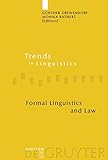Formal Linguistics and Law / ed. by Günther Grewendorf, Monika Rathert.
Material type: TextSeries: Trends in Linguistics. Studies and Monographs [TiLSM] ; 212Publisher: Berlin ; Boston : De Gruyter Mouton, [2009]Copyright date: ©2009Description: 1 online resource (435 p.) : Figs. and tabsContent type:
TextSeries: Trends in Linguistics. Studies and Monographs [TiLSM] ; 212Publisher: Berlin ; Boston : De Gruyter Mouton, [2009]Copyright date: ©2009Description: 1 online resource (435 p.) : Figs. and tabsContent type: - 9783110218381
- 9783110218398
- 340.14 22/ger
- K213 .F668 2009
- online - DeGruyter
- Issued also in print.
| Item type | Current library | Call number | URL | Status | Notes | Barcode | |
|---|---|---|---|---|---|---|---|
 eBook
eBook
|
Biblioteca "Angelicum" Pont. Univ. S.Tommaso d'Aquino Nuvola online | online - DeGruyter (Browse shelf(Opens below)) | Online access | Not for loan (Accesso limitato) | Accesso per gli utenti autorizzati / Access for authorized users | (dgr)9783110218398 |
Frontmatter -- Table of contents -- Acknowledgements -- List of contributors -- Language and Law – new applications of formal linguistics -- Part 1. Understanding the law: The contribution of semantics and psycholinguistics -- Law matters, syntax matters and semantics matters -- Improving the comprehensibility of German court decisions -- Understanding a Riester-pension: A reply to Becker and Klein (2008) -- Part 2. Identifying the criminal: The contribution of phonetics and text/corpus linguistics -- Forensic phonetics and the influence of speaking style on global measures of fundamental frequency -- Phonetic cues to speaker age: A longitudinal study -- Does speech reveal one’s age? On the use of gerontolinguistic topics for forensic authorship analysis -- Part 3. Organizing legal systems: The contribution of computational linguistics and artificial intelligence -- Definition extraction from court decisions using computational linguistic technology -- Making sense of legal texts -- Interfacing between different legal systems using the examples of N-Lex and EUR-Lex -- The LOIS project and beyond -- Part 4. Multilingualism and the law: The contribution of translation studies -- Multilingualism in the European Union Status quo and perspectives: The reference language model -- Drafting and interpretation of EU law – paradoxes of legal multilingualism -- Multilingual law drafting in Switzerland -- A modular approach to legal drafting and translation -- Backmatter
restricted access online access with authorization star
http://purl.org/coar/access_right/c_16ec
This volume explores new interfaces between linguistics and jurisprudence. Its theoretical and methodological importance lies in showing that many questions asked within the field of language and law receive satisfactory answers from formal linguistics. The book starts with a paper by the two editors in which they explain why the volume - as a whole and with its individual papers - is an innovation in the field of language and law. In addition, an overview about the most important research projects on language and law is given. The first chapter of the book is on understanding the law. Jurists and laypersons always ask for the precise meaning of a certain piece of the law. In linguistics, the discipline investigating 'meaning' is semantics; thus, it is to be expected that semantics can contribute to a correct understanding of the law. Chapter 1 also investigates the alleged incomprehensibility of legal language with the help of psycholinguistics. Chapter 2 is on identifying the criminal. To find the author of a blackmailer's letter, text/ corpus linguistics is instrumental. If the blackmailer uses the telephone instead of the letter, speaker identification and phonetics are necessary. The BKA stores all blackmailing letters in a database, but databases are only one possibility of organizing legal systems; another possibility is the application of tools from computational linguistics and artificial intelligence. These tools can be useful to handle terminology, to retrieve information, or to model legal theorizing in a formal system. Chapter 3 demonstrates a variety of examples of organizing legal systems. The topic of chapter 4 is multilingualism and the law. The European legislation is a product of legal and linguistic diversity, as the member states do not only differ in languages but also in their legal systems. One paper shows how Switzerland handles its multilingualism in legal drafting. The input of translation studies is of course vital in this field of research. An index for both subjects and persons complements the volume.
Issued also in print.
Mode of access: Internet via World Wide Web.
In English.
Description based on online resource; title from PDF title page (publisher's Web site, viewed 28. Feb 2023)


